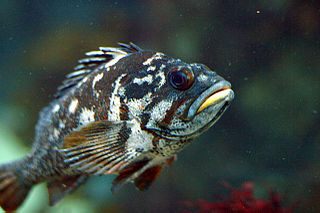
The gopher rockfish, also known as the gopher sea perch, is a species of marine ray-finned fish belonging to the subfamily Sebastinae, the rockfishes, part of the family Scorpaenidae. It is found in the eastern Pacific, primarily off California.

The blue rockfish or blue seaperch, is a species of marine ray-finned fish belonging to the subfamily Sebastinae, the rockfishes, part of the family Scorpaenidae. It is found in the northeastern Pacific Ocean, ranging from northern Baja California to central Oregon.
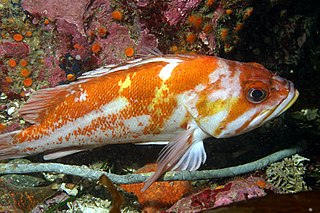
The copper rockfish, also known as the copper seaperch, is a species of marine ray-finned fish belonging to the subfamily Sebastinae, the rockfishes, part of the family Scorpaenidae. It is found in the eastern Pacific.

The bocaccio rockfish is a species of marine ray-finned fish belonging to the subfamily Sebastinae, the rockfishes, part of the family Scorpaenidae, It is found in the northeast Pacific Ocean.

The widow rockfish, or brown bomber, is a species of marine ray-finned fish belonging to the subfamily Sebastinae, the rockfishes, part of the family Scorpaenidae. It is found in the northeastern Pacific Ocean.

Sebastes miniatus, the vermilion rockfish, vermilion seaperch, red snapper, red rock cod, and rasher, is a species of marine ray-finned fish belonging to the subfamily Sebastinae, the rockfishes, part of the family Scorpaenidae. It is native to the waters of the Pacific Ocean off western North America from Baja California to Alaska.

The yellowtail rockfish, or yellowtail seaperch, is a species of marine ray-finned fish belonging to the subfamily Sebastinae, the rockfishes, part of the family Scorpaenidae. This species lives mainly off the coast of western North America from California to Alaska.

Sebastes goodei, the chilipepper rockfish and chilipepper, is a species of marine ray-finned fish belonging to the subfamily Sebastinae, the rockfishes, part of the family Scorpaenidae. This species lives mainly off the coast of western North America from Baja California to Vancouver.

The starry rockfish, also known as the spotted corsair, spotted rockfish, chinafish, and red rock cod, is a species of marine ray-finned fish belonging to the subfamily Sebastinae, the rockfishes, part of the family Scorpaenidae. It is found in the eastern Pacific Ocean.

The yelloweye rockfish is a species of marine ray-finned fish belonging to the subfamily Sebastinae, the rockfishes, part of the family Scorpaenidae. and one of the biggest members of the genus Sebastes. Its name derives from its coloration. It is also locally known as "red snapper", not to be confused with the warm-water Atlantic species Lutjanus campechanus that formally carries the name red snapper. The yelloweye is one of the world's longest-lived fish species, and is cited to live to a maximum of 114 to 120 years of age. As they grow older, they change in color, from reddish in youth, to bright orange in adulthood, to pale yellow in old age. Yelloweye live in rocky areas and feed on small fish and other rockfish. They reside in the East Pacific and range from Baja California to Dutch Harbor in Alaska.
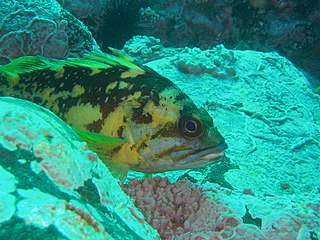
Sebastes chrysomelas, commonly known as the black-and-yellow rockfish, is a marine fish species of the family Sebastidae. It is found in rocky areas in the Pacific off California and Baja California. Although it is similar in appearance to the China rockfish, the black-and-yellow rockfish lacks the China's long yellow streak. The China rockfish has a continuous yellow band while the black-and-yellow rockfish only has scattered patches of yellow across its body.
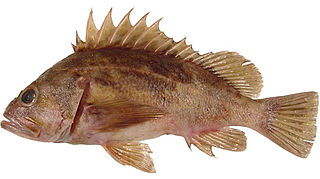
The brown rockfish, whose other names include brown seaperch, chocolate bass, brown bass and brown bomber, is a species of marine ray-finned fish belonging to the subfamily Sebastinae, the rockfishes, part of the family Scorpaenidae. It is found in the northeastern Pacific Ocean.

The redbanded rockfish, also known as the bandit, barber pole, flag rockfish, Spanish flag, Hollywood, convict, and canary, is a species of marine ray-finned fish belonging to the subfamily Sebastinae, the rockfishes, part of the family Scorpaenidae. It is found in the northern Pacific Ocean.

Sebastes aurora, the aurora rockfish, is a species of marine ray-finned fish belonging to the subfamily Sebastinae, the rockfishes, part of the family Scorpaenidae. It is found in the northeastern Pacific Ocean.

Sebastes diploproa, the splitnose rockfish, is a species of marine ray-finned fish belonging to the subfamily Sebastinae, the rockfishes, part of the family Scorpaenidae. It is found in the northeastern Pacific Ocean.

Sebastes elongatus, the greenstriped rockfish, striped rockfish, strawberry rockfish, poinsettas, reina or serena, is a species of marine ray-finned fish belonging to the subfamily Sebastinae, the rockfishes, part of the family Scorpaenidae. It is found in the northeastern Pacific Ocean.
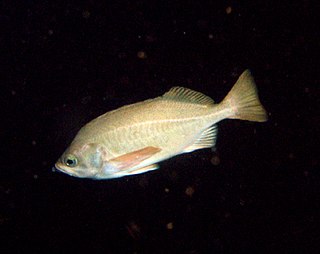
Sebastes ovalis, the speckled rockfish, is a species of marine ray-finned fish belonging to the subfamily Sebastinae, the rockfishes, part of the family Scorpaenidae. It is found in deep rocky areas of the Eastern Pacific.
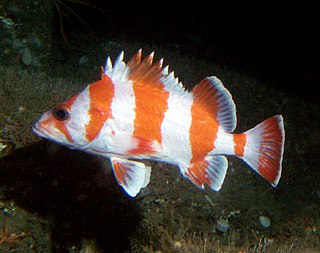
Sebastes rubrivinctus, also known as the flag rockfish, Spanish flag, redbanded rockfish or barberpole, is a species of marine ray-finned fish belonging to the subfamily Sebastinae, the rockfishes, part of the family Scorpaenidae. It is found in the Eastern Pacific.

Sebastes semicinctus, the halfbanded rockfish, is a species of marine ray-finned fish belonging to the subfamily Sebastinae, the rockfishes, part of the family Scorpaenidae. It is found in the Eastern Pacific.
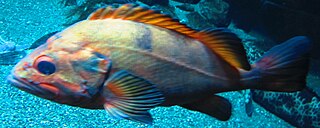
Sebastes melanostictus, the blackspotted rockfish, is a species of marine ray-finned fish belonging to the subfamily Sebastinae, the rockfishes, part of the family Scorpaenidae. It is found in the northern Pacific Ocean.




















